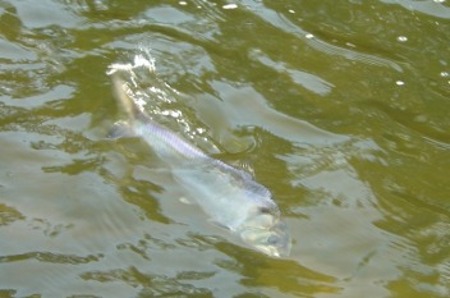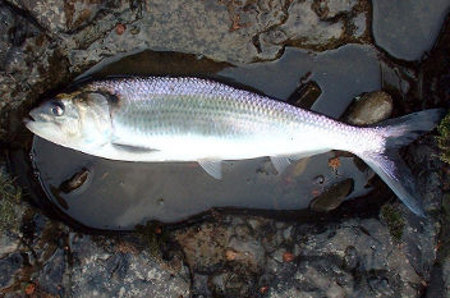Shad
Shad are a member of the herring family that spawns in freshwater.
There are believed to be two types in the Wye: twaite shad (Alosa fallax) and allis shad (Alosa alosa) although considerable hybridisation occurs. It is difficult to distinguish these close relatives. Both fish have streamlined bodies covered with distinct, large, circular scales which form a toothed edge on the lower margin and an adipose membrane which partially covers each eye. Rarely exceeding 40 cm length, twaite shad are usually smaller than pure bred allis, which measure as much as 55cm. However, the only reliable way of separating the two species is to examine the gills - twaite shad have only 40-60 gill- rakers (comb-like structures that are used to filter zooplankton) on the first gill arch, whereas allis have 90-130.
Shad return from the sea to spawn in spring, usually between April and May, hence the alternative name of 'May fish'. The habitat requirements of twaite shad are not fully understood. On the Wye and Usk, they spawn at night on gravels and sands at the tail of deeper pools, in which the fish congregate. The eggs are released into the water column, sinking into the interstices between the substrate. The majority of adults die after spawning, though UK populations appear to have an unusually high proportion of repeat spawners - up to 25%. After hatching the fry develop and slowly drift downstream. Recruitment seems to be highest in warm years, and high flows between May and August may result in fry being washed prematurely out to sea.


Relatively little information is available on the habitat requirements of allis shad in freshwater. It spends its adult life in coastal waters and estuaries but migrates into rivers to spawn, swimming up to 800 km upstream in continental Europe. However, both species of shad do not readily traverse obstacles to migration such as dams, weirs or bridge footings and this has been a major cause of their decline. Like twaite shad, adults spawn at night with a great deal of noisy splashing; the eggs are released into the current where they settle among gaps in gravelly substrates. Spawning sites tend to be used year after year. Almost all adult allis die after spawning.
Twaite shad are found along the western coastline of Europe, from southern Norway to Morocco and along the eastern Mediterranean, but have declined substantially throughout Europe. Allis shad are rare and declining throughout their range on the western coasts of Europe, from southern Norway to Spain, and in the Mediterranean eastwards to northern Italy. The most successful breeding populations are thought to be in a few rivers in western France and Portugal. Population declines in both species in many parts of Europe have been attributed to pollution, overfishing and migratory route obstructions.
In the UK, spawning stocks of twaite shad are known to occur in only a few rivers in Wales and on the England/Wales border, flowing into the Severn estuary no spawning stocks are known north of this, although the species is present in south-west Scotland, in rivers flowing into the Solway Firth.
Allis shad are rare in the UK. Although formerly known to spawn in several British river systems, the only recently-confirmed spawning site is in the Tamar Estuary (Plymouth Sound and Estuaries cSAC). There is probably a spawning population in the Solway Firth area but rivers in the Severn catchment may no longer support viable breeding populations.
Shad in the Irfon
Twaite shad remain abundant in the Wye, which contains the largest spawning population in the UK of this species. They spawn in the lowest 4km of the Irfon (130km from the tidal limit). Determination of whether allis shad are present and where they spawn has not been made but every year some outsized "twaite" shad are accidentally caught by anglers fishing for salmon, which were almost certainly allis or allis/twaite crosses. The Foundation was responsible for the purchase of commercial fisheries in the estuary that formerly took a considerable number of shad. The benefits of ISAC to shad are difficult to estimate. Ecosystem recovery, which is what the project has done, could result in many extra adults returning each year to spawn. Certainly, this project has helped to secure this status.
